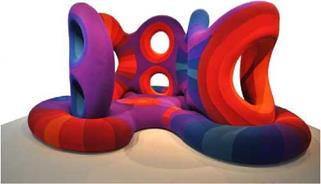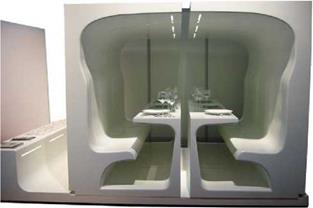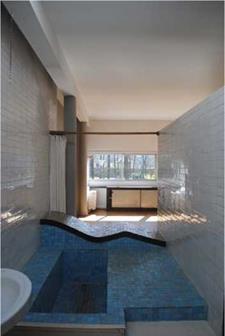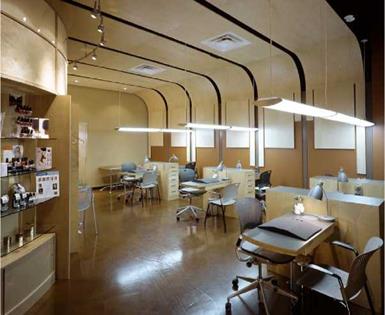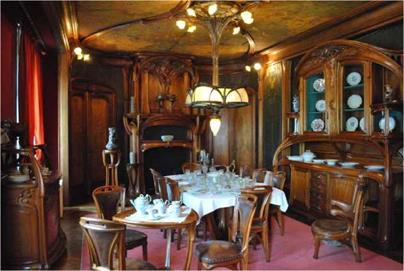furniture
• noun 1. the movable articles that are used to make a room or building suitable for living or
working in, such as tables, chairs, or desks. 2. the small accessories or fittings that are
required for a particular task or function: door furniture.2
By many accounts, furniture includes a broad range of moveable objects organized in four main categories:
■ Human body support devices (Figures 1.2 and 1.3)
■ Surfaces and objects to support various activities (Figures 1.4 and 1.5)
■ Storage and display pieces (Figures 1.6 and 1.7)
■ Spatial partitions3 (Figures 1.8 and 1.9)
Furniture pieces are designed and fabricated to assist in the many ways people sit and rest, work and play, organize or display items, and partition space. This view suggests a broad utilitarian framework, in which function is perceived to be the primary intended purpose of furniture. Although function, utility, and social use are important aspects of the performance of furniture, rarely does function alone inspire great design. Furniture design draws upon ideas of beauty, principles of design, theory, material properties, fabrication technologies, business economies, environmental design matters, and the surrounding spatial context in which it is placed, all of which are integral and intertwined with function, utility, and social use. Considerations that influence what we think about and feel regarding furniture design include:
■ Aesthetics (the meaning of form)
■ Historical precedent (examples from the past)
■ Principles of design (i. e., unity, harmony, hierarchy, spatial order)
■ Function and social use (ergonomics, comfort, proxemics)
■ Design processes (sketching, iterative overlays, model studies, digital modeling, full-scale working prototypes, collage assemblies)
■ Material (classification, characteristics, properties, availability, cost)
■ Fabrication processes (hand, power, digital)
■ Environmental design matters (sustainability, renewable materials, off-gassing)
■ Surrounding context (the spatial setting for furniture)
■ Professional practice (economic, legal, and business decisions)
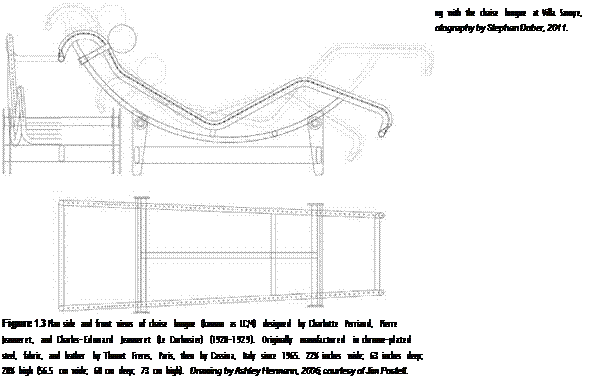
A goal in designing furniture is to consider all design aspects in a comprehensive and integrated manner, while maintaining focus and critical engagement upon the primary concepts and ideas that inspire design.
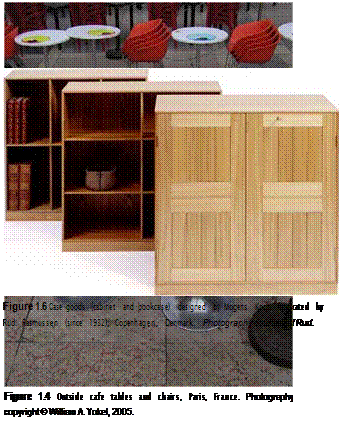 |
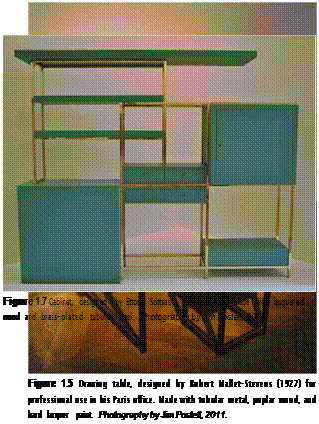 |
Utilitarian considerations can channel the development and refinement of design ideas but rarely inspire them. Utility is grounded by specific categories of social use, associated with the broader classifications of building and zoning nomenclature. In this book, categories of social use include:
|
|
|
■ Health care
■ Hospitality
■ Institutional
■ Office
■ Recreational
■ Religious
■ Residential
■ Retail
■ Storage
Broad categories of social use are dependent on particular activities and affected by specific circumstances, which are nearly always influenced by place, occupancy, and time. As an example, day care furniture is a specific type of furniture cross- linked with institutional and residential categories. A law firm is a specific type of office classification, as is an accounting firm or a telemarketing company. Furniture for a Catholic church, a Jewish synagogue, or Islamic mosque, falls under a liturgical classification. These factors and circumstances are discussed in Chapter 2.
The word furniture is derived from European verbs, nouns, and adjectives. The French verb fournir means "to furnish." Furniture provides a place setting for work, rest, and play. It also contributes to the ambiance and style of interior space (Figure 1.10). Furniture provides people with desired items and necessary equipment that complement and complete interior space.
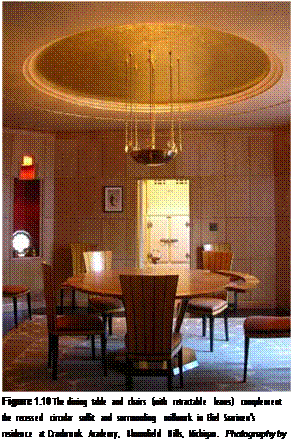 The Latin adjective mobile means "movable," which is an important characteristic of furniture. The French meubles, the Turkish mobilya, and the Danish m0bel all translate into the English word furniture. Freedom from the physical structure of a building provides designers with an opportunity to create spatial relationships between movable elements and built-in
The Latin adjective mobile means "movable," which is an important characteristic of furniture. The French meubles, the Turkish mobilya, and the Danish m0bel all translate into the English word furniture. Freedom from the physical structure of a building provides designers with an opportunity to create spatial relationships between movable elements and built-in
components. The creation of spatial relationships through the size, location, and orientation of furniture pieces places furniture design within the disciplines of architecture and interior design.
Spatial order and spatial organizations include:
■ Grid: a regular tessellation that divides space into a series of contiguous cells, which can then be used for spatial indexing purposes. Grids can be generated from square or rectangular cells, triangular, circular, or, hexagonal formations.
■ Linear: relating to, consisting of, or using lines in form or in spatial sequence.
■ Centralized: drawing spatial relationships into, around, or toward a central area or point.
■  Radial: elements radiating out from a central area or point. (spiraling or swirling) in a circular, lineal, or spiral path.
Radial: elements radiating out from a central area or point. (spiraling or swirling) in a circular, lineal, or spiral path.
■ Cluster: a small group of elements gathered closely together (Figure 1.11).
Though furnishings are nearly always freestanding and movable, some pieces challenge the conventional paradigm by being mechanically attached to a floor, wall, or ceiling (see Figures 1.12 and 1.13) and therefore lose the characteristic of their mobility. In either scenario, interior space is made complete through the size, location, orientation, and surface treatment of tangible built-form and intangible use.
|
|
|
|
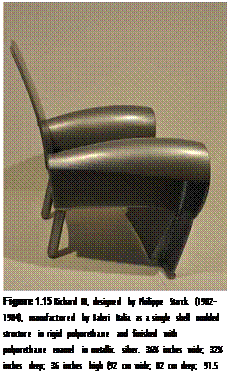 Architecture embraces the art and design of building. It is site dependent and site responsive. Many architects have designed custom furniture pieces to complement their buildings and complete their interior spaces. Alvar Aalto, Antoni Gaudi, Charles Rennie Mackintosh, Eugene Vallin, and Frank Lloyd Wright were architects who routinely sought to accomplish this goal. Furniture can contribute significantly to its architectural setting, designed and fabricated as one-of-a-kind pieces, specifically to complement and complete a room, space, or landscape (see Figure 1.14).
Architecture embraces the art and design of building. It is site dependent and site responsive. Many architects have designed custom furniture pieces to complement their buildings and complete their interior spaces. Alvar Aalto, Antoni Gaudi, Charles Rennie Mackintosh, Eugene Vallin, and Frank Lloyd Wright were architects who routinely sought to accomplish this goal. Furniture can contribute significantly to its architectural setting, designed and fabricated as one-of-a-kind pieces, specifically to complement and complete a room, space, or landscape (see Figure 1.14).
Industrial design is a relatively young discipline with mass production and mass customization as its primary focus and disciplinary theme. Furniture design provides opportunity for exercising these core values and, therefore, finds itself aligned with the discipline of industrial design. Digital fabrication techniques, workmanship, assembly processes, and packaging are important to both industrial design and furniture production because of the shared dependence each discipline has with mass production and mass customization. Furniture pieces that are designed, fabricated, and branded as industrial design products include ergonomic task chairs, folding tables, and modular shelving units. These products are designed to have identical or deliberate quantitative outcomes resulting from industrial production technologies and are not conceived as site-specific furnishings. Renowned designers, whose furniture designs are dependent on mass-production and mass-customization technologies include Achille Castiglioni, Antonio Citterio, Bruce Hannah, Philippe Starck, and Bill Stumpf (see Figure 1.15).
Art, as a process, is steeped in the creation of making things. More often than not, artwork produced by an artist reveals, among other qualities, the mark of the maker. Furniture aligns itself with and is marketed as fine art when the nature of craft and craftsmanship (workmanship of risk) is revealed through the process of making. Furniture, when considered a work of art, results from personal skill and subjective judgment in the production and fabrication of a one-of-a-kind piece. Furniture pieces made by Ron Arad, Wendell Castle, Emile Galle, Sam Maloof, George Nakashima, and Andrea Zittel have been exhibited in galleries and museums and the pieces made by their own hand are marketed as fine art (see Figure 1.16).
|
Figure 1.14 Eugene Vallin, salle a manger (dining room), Musee de l Ecole de Nancy. Photography by Jim Postell, 2011. |
 |
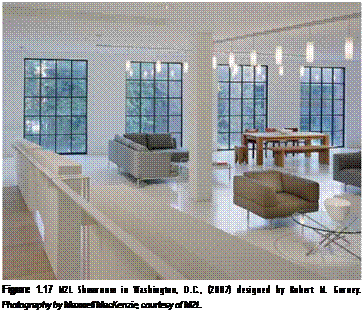 |
Buying, selling, and marketing furniture is a business. Sales are influenced, in part, by the display of furniture in a particular setting (i. e., store, showroom, ad, journal, book, exhibit, or web site). Price, quality, function, aesthetics, historical context, and branded appeal also influence sales. As a business, furniture is carefully marketed through specific venues with consideration towards the competition and broader market demand for similar products. Furniture companies such as Cassina and Knoll invest heavily into carefully designed environments to display their furniture product line. Furniture businesses follow suit. From Paustian in Copenhagen to M2L in New York, Boston, and Washington; to the office furniture showrooms in Chicago’s Merchandise Mart; to Voltage in Cincinnati, high-end furniture showrooms play an important role not only in providing an environment in which to display and sell furniture and furnishings but also to inform the public and give voice to furniture design in a larger historical, societal, and cultural context.
M2L is a business dedicated to modern design. Started in 1985, the company has showrooms in New York, Boston, and Washington, D. C. M2L is a source for high-end residential and office furniture, whose designs span the twentieth century and include collections from many modern masters, such as Josef Hoffmann, Eileen Gray, and Marcel Breuer. M2L’s showroom in Georgetown’s Design District provides a modern setting among turn-of-the – century industrial warehouses. The furniture showroom is designed as a beautiful, minimal white interior space, providing an environment best suited to display the collection of furniture and furnishings available through M2L (Figure 1.17).
DESIGN
design
• noun 1. a plan or drawing produced to show the look and function or workings of something before it is built or made. 2. the art or action of producing such a plan or drawing. 3. underlying purpose or planning: the appearance of design in the universe. 4. a decorative pattern.
• verb 1. conceive and produce a design for. 2. plan or intend for a purpose.4
One can think of design as structured play.5 It’s a process resulting from creative thinking, intuitive judgment, and hard work. As a process, design develops through a working method that is shaped by technical information, informed by theory, and dependent on communication skills. Design ideas develop within a conceptual and contextual framework and are dependent on the operations and abilities of the designer’s hand and head.
The design process utilizes both the right and left hemispheres of the brain. The left side of the brain processes information in a linear manner, working from part to whole relationships. It takes pieces of information and organizes them in a logical order, then it draws conclusions. The left-brain person would enjoy making schedules and planning the fabrication of furniture. The right side of the brain, however, processes from whole to parts, holistically. It starts with the big picture, not with specific details. The right-brain person wants to see, feel, or touch furniture. Thus furniture designers who can activate both sides of the brain often enhance the design process, furthering the considerations of conceptual, structural, functional, tactile, aesthetic, spatial, economic, and cultural needs and desires, all at the same time.
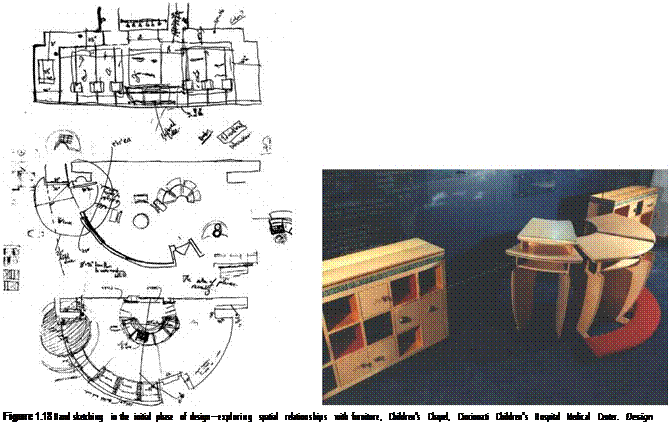
The word design is distinct from the word project. While design entails processes of inquiry and methods for exploring and synthesizing ideas (Figure 1.18), a project is the coherent resolution of purpose and presence (Figure 1.19). At some point in time, design efforts will transform into projects. A project can be revealed in a drawing, model, working prototype, or fabricated work. It’s not the medium that distinguishes a design from a project; rather, it is the presence of resolved and synthesized aspects, clarity of idea, function, purpose, and, very often, the intent to make real.
Figure 1.19 Children’s Chapel, Cincinnati, Ohio—fabricated and installed furnishings by Heartwood Furniture Company, 1995. Photography by Michael Toombs, 1995.
Design 9
The words design and designate are derived from the Latin verb designare. Designare translates "to mark out," taken from de, "of," and signare, "to mark," or the noun signum, "a mark or sign."6 The Italian word for project is laprogettazione, referring to the planning stage between design and fabrication. Il progetto translates into "the plan." The word design is sometimes used to mean "the plan" and can imply planning or intending for a purpose.
At the core of designing furniture is a body of knowledge and the skills necessary to integrate the tangible and intangible aspects that become furniture. Tangible aspects include:
■ Materials (characteristics, workability, and finish qualities)
■ Fabrication processes (tools, performance, quality, and limitations)
■ Resources (time, money, and access to equipment and supplies)
Intangible aspects include:
■ The program (intention, purpose, function)
■ Theory and history (inquiry, rationale, precedent)
■ Ergonomics and proxemics (designing for a set of activities, within the limits of the human body and the study of how people communicate in and through space)
■ Knowledge about the human body and the human condition
■ The design process
■ Marketing and branding strategies
■ Professional practice
Designers can build upon their understanding of the present and be better equipped to foresee into the future when they have gained insight from the successes and failures, processes, and aspirations of others in the past. Look carefully at the design and fabrication processes from the past. Consider the innovative use, available materials, the joinery, and aesthetics, all of which can inform and inspire new furniture designs.
Design skills include the ability to graphically communicate and physically model ideas. Though technical instruction can be taught, design skills need to be exercised and will improve with experience. Furniture designers need to learn how to design, sketch, draw, draft, make study models, and use computer programs, while simultaneously developing a working knowledge about materials, fabrication techniques, and the human body, when they actively design furniture. In regard to the skills and knowledge necessary to design furniture, experience in both designing and making furniture is perhaps the best teacher a student can have.

